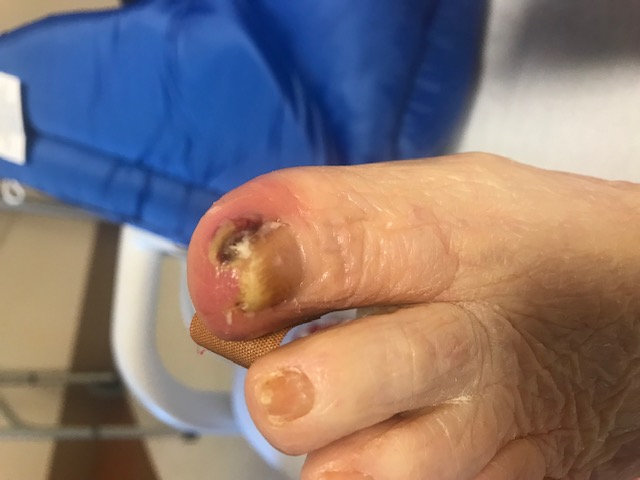[1]
Bryant A, Knox A. Ingrown toenails: the role of the GP. Australian family physician. 2015 Mar:44(3):102-5
[PubMed PMID: 25770573]
[2]
DeLauro NM, DeLauro TM. Onychocryptosis. Clinics in podiatric medicine and surgery. 2004 Oct:21(4):617-30, vii
[PubMed PMID: 15450901]
[3]
Park DH, Singh D. The management of ingrowing toenails. BMJ (Clinical research ed.). 2012 Apr 3:344():e2089. doi: 10.1136/bmj.e2089. Epub 2012 Apr 3
[PubMed PMID: 22491483]
[4]
Wollina U. Systemic Drug-induced Chronic Paronychia and Periungual Pyogenic Granuloma. Indian dermatology online journal. 2018 Sep-Oct:9(5):293-298. doi: 10.4103/idoj.IDOJ_133_18. Epub
[PubMed PMID: 30258794]
[5]
Langford DT, Burke C, Robertson K. Risk factors in onychocryptosis. The British journal of surgery. 1989 Jan:76(1):45-8
[PubMed PMID: 2917259]
[6]
Cho SY, Kim YC, Choi JW. Epidemiology and bone-related comorbidities of ingrown nail: A nationwide population-based study. The Journal of dermatology. 2018 Dec:45(12):1418-1424. doi: 10.1111/1346-8138.14659. Epub 2018 Sep 28
[PubMed PMID: 30264897]
[7]
Kose O, Celiktas M, Kisin B, Ozyurek S, Yigit S. Is there a relationship between forefoot alignment and ingrown toenail? A case-control study. Foot & ankle specialist. 2011 Feb:4(1):14-7. doi: 10.1177/1938640010382293. Epub 2010 Oct 4
[PubMed PMID: 20921151]
Level 2 (mid-level) evidence
[8]
Ezekian B, Englum BR, Gilmore BF, Kim J, Leraas HJ, Rice HE. Onychocryptosis in the Pediatric Patient. Clinical pediatrics. 2017 Feb:56(2):109-114. doi: 10.1177/0009922816678180. Epub 2016 Dec 8
[PubMed PMID: 27941086]
[9]
Khunger N, Kandhari R. Ingrown toenails. Indian journal of dermatology, venereology and leprology. 2012 May-Jun:78(3):279-89. doi: 10.4103/0378-6323.95442. Epub
[PubMed PMID: 22565427]
[10]
Gera SK, PG Zaini DKH, Wang S, Abdul Rahaman SHB, Chia RF, Lim KBL. Ingrowing toenails in children and adolescents: is nail avulsion superior to nonoperative treatment? Singapore medical journal. 2019 Feb:60(2):94-96. doi: 10.11622/smedj.2018106. Epub
[PubMed PMID: 30843080]
[11]
Romero-Pérez D, Betlloch-Mas I, Encabo-Durán B. Onychocryptosis: a long-term retrospective and comparative follow-up study of surgical and phenol chemical matricectomy in 520 procedures. International journal of dermatology. 2017 Feb:56(2):221-224. doi: 10.1111/ijd.13406. Epub 2016 Oct 12
[PubMed PMID: 27734499]
Level 2 (mid-level) evidence
[12]
Freiberg A, Dougherty S. A review of management of ingrown toenails and onychogryphosis. Canadian family physician Medecin de famille canadien. 1988 Dec:34():2675-81
[PubMed PMID: 20469491]
[15]
Woo SH, Kim IH. Surgical pearl: nail edge separation with dental floss for ingrown toenails. Journal of the American Academy of Dermatology. 2004 Jun:50(6):939-40
[PubMed PMID: 15153897]
[16]
Erdem O, Dağtaş BB, Koku Aksu AE, Göktay F. Suture-secured modified gutter splint method for the conservative treatment of ingrown toenails. Journal of the American Academy of Dermatology. 2023 Jun:88(6):e301. doi: 10.1016/j.jaad.2021.02.021. Epub 2021 Feb 12
[PubMed PMID: 33582261]
[17]
Taheri A, Mansoori P, Alinia H, Lewallen R, Feldman SR. A conservative method to gutter splint ingrown toenails. JAMA dermatology. 2014 Dec:150(12):1359-60. doi: 10.1001/jamadermatol.2014.1757. Epub
[PubMed PMID: 25188750]
[19]
Watabe A, Yamasaki K, Hashimoto A, Aiba S. Retrospective evaluation of conservative treatment for 140 ingrown toenails with a novel taping procedure. Acta dermato-venereologica. 2015 Sep:95(7):822-5. doi: 10.2340/00015555-2065. Epub
[PubMed PMID: 25669233]
Level 2 (mid-level) evidence
[20]
Ergün T, Korkmaz M, Ergün D, Turan K, Muratoğlu OG, Çabuk H. Treatment Of Ingrown Toenail with a Minimally Invasive Nail Fixator: Comparative Study with Winograd Technique. Journal of the American Podiatric Medical Association. 2022 Aug 29:():1-16. doi: 10.7547/22-024. Epub 2022 Aug 29
[PubMed PMID: 36040860]
Level 2 (mid-level) evidence
[21]
Vinay K, Narayan Ravivarma V, Thakur V, Choudhary R, Narang T, Dogra S, Varthya SB. Efficacy and safety of phenol-based partial matricectomy in treatment of onychocryptosis: A systematic review and meta-analysis. Journal of the European Academy of Dermatology and Venereology : JEADV. 2022 Apr:36(4):526-535. doi: 10.1111/jdv.17871. Epub 2022 Jan 7
[PubMed PMID: 34913204]
Level 1 (high-level) evidence
[22]
DeBrule MB. Operative treatment of ingrown toenail by nail fold resection without matricectomy. Journal of the American Podiatric Medical Association. 2015 Jul:105(4):295-301. doi: 10.7547/13-121.1. Epub
[PubMed PMID: 26218152]
[23]
Livingston MH, Coriolano K, Jones SA. Nonrandomized assessment of ingrown toenails treated with excision of skinfold rather than toenail (NAILTEST): An observational study of the Vandenbos procedure. Journal of pediatric surgery. 2017 May:52(5):832-836. doi: 10.1016/j.jpedsurg.2017.01.029. Epub 2017 Jan 29
[PubMed PMID: 28190555]
Level 2 (mid-level) evidence
[24]
Haneke E. Controversies in the treatment of ingrown nails. Dermatology research and practice. 2012:2012():783924. doi: 10.1155/2012/783924. Epub 2012 May 20
[PubMed PMID: 22675345]


